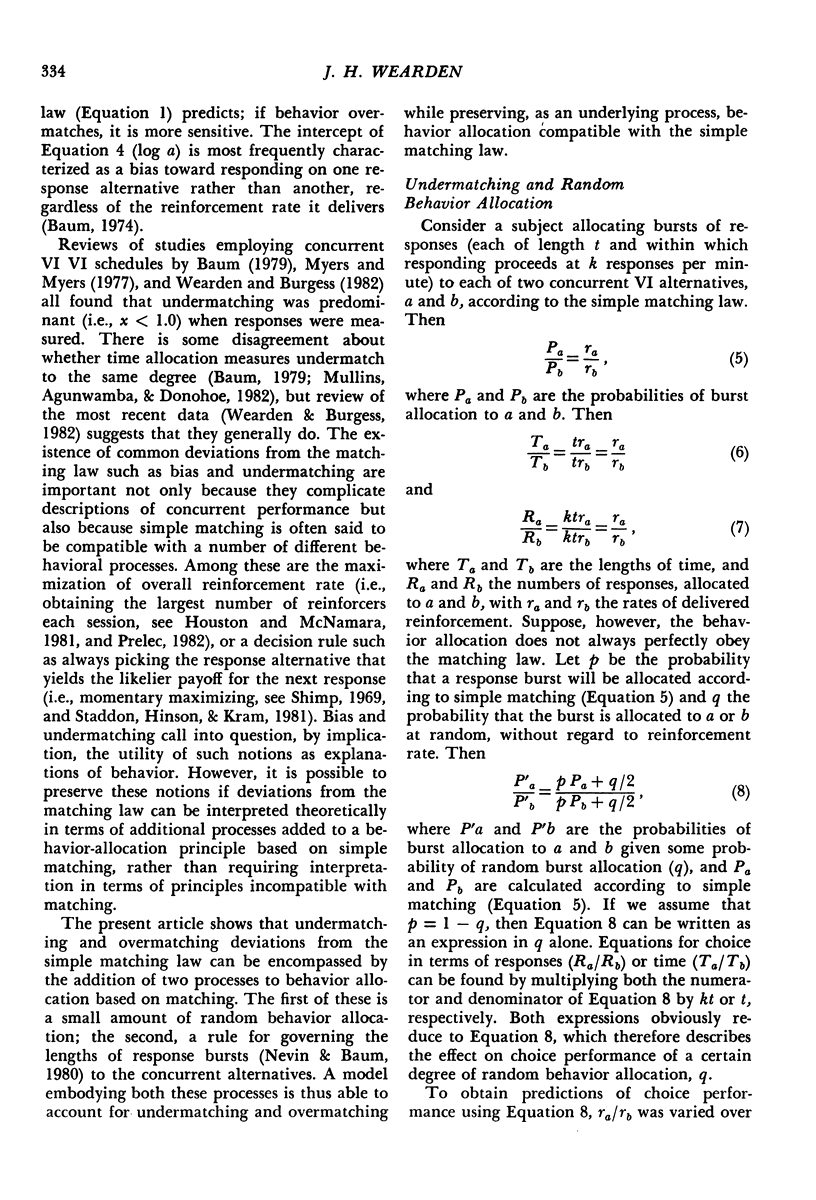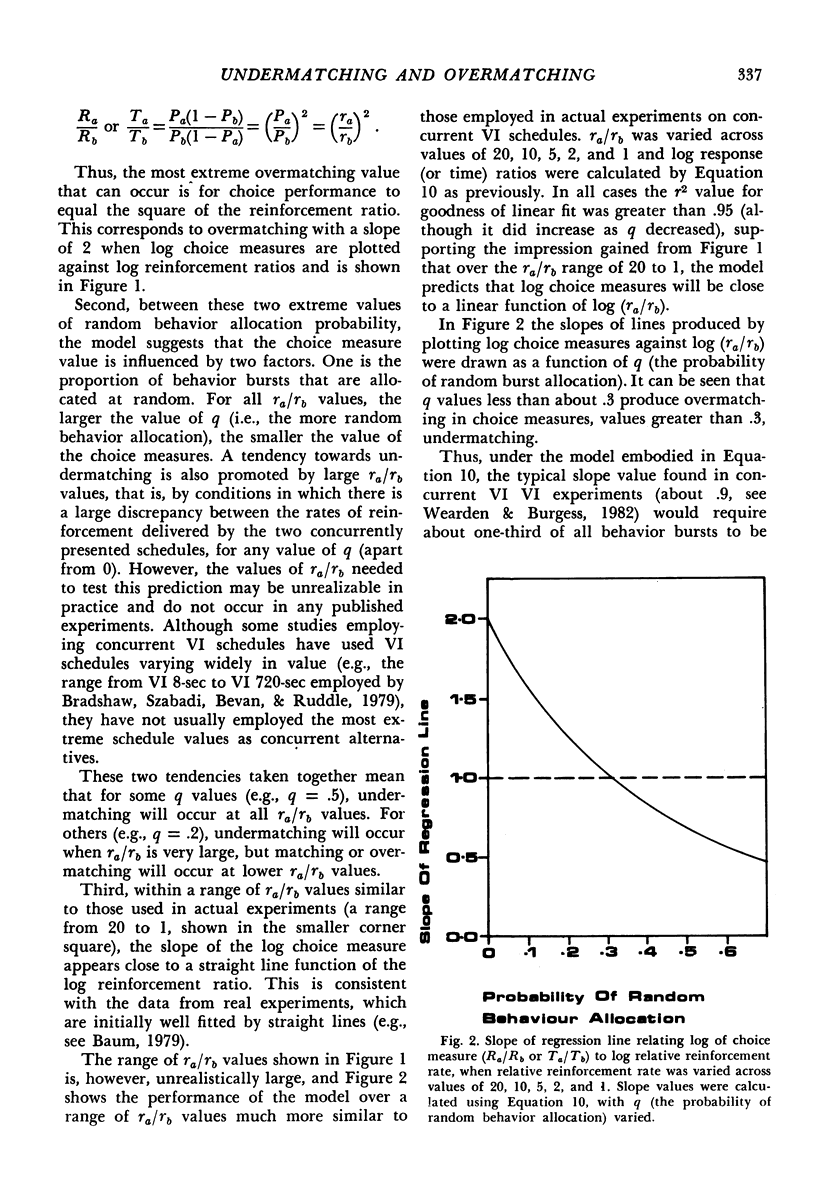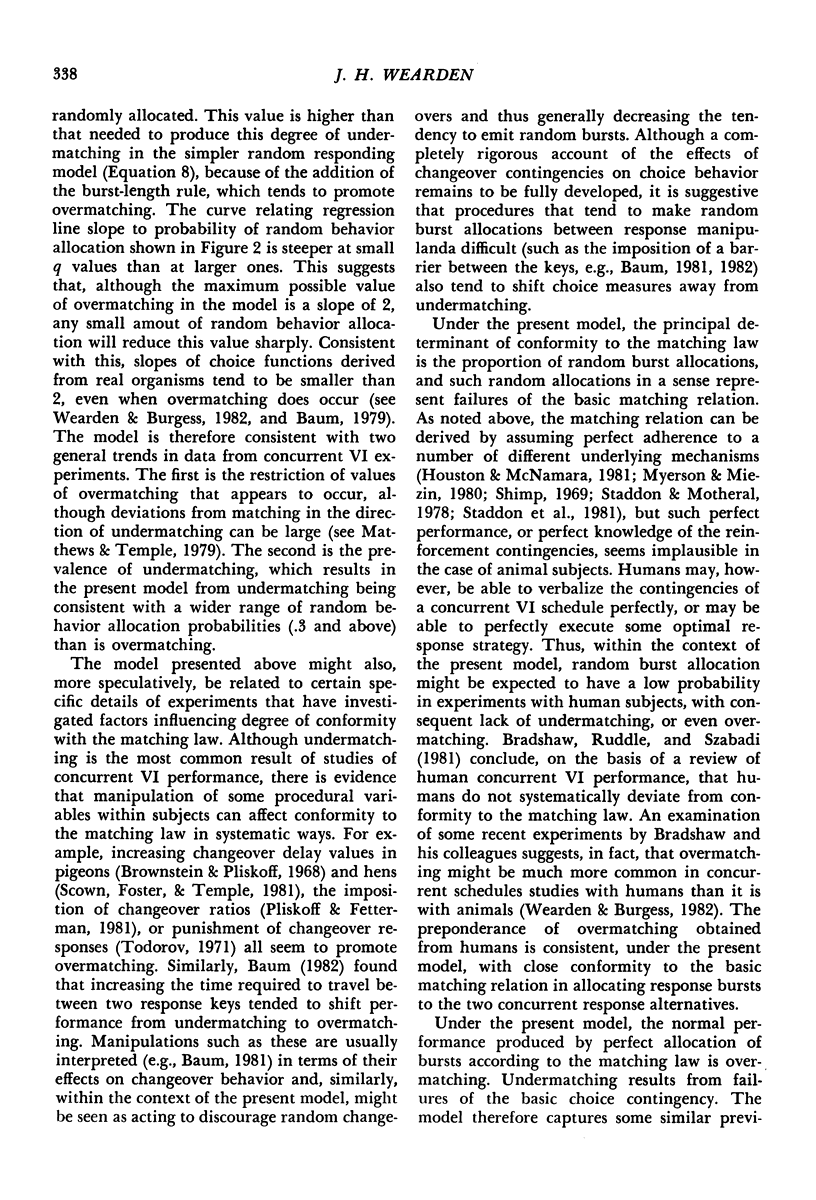Abstract
A model of performance under concurrent variable-interval reinforcement schedules that takes as its starting point the hypothetical “burst” structure of operant responding is presented. Undermatching and overmatching are derived from two separate, and opposing, tendencies. The first is a tendency to allocate a certain proportion of response bursts randomly to a response alternative without regard for the rate of reinforcement it provides, others being allocated according to the simple matching law. This produces undermatching. The second is a tendency to prolong response bursts that have a high probability of initiation relative to those for which initiation probability is lower. This process produces overmatching. A model embodying both tendencies predicts (1) that undermatching will be more common than overmatching, (2) that overmatching, when it occurs, will tend to be of limited extent. Both predictions are consistent with available data. The model thus accounts for undermatching and overmatching deviations from the matching law in terms of additional processes added on to behavior allocation obeying the simple matching relation. Such a model thus enables processes that have been hypothesized to underlie matching, such as some type of reinforcement rate or probability optimization, to remain as explanatory mechanisms even though the simple matching law may not generally be obeyed.
Keywords: concurrent schedules, undermatching, overmatching, random-response allocation, burst length
Full text
PDF







Selected References
These references are in PubMed. This may not be the complete list of references from this article.
- Baum W. M. Choice, changeover, and travel. J Exp Anal Behav. 1982 Jul;38(1):35–49. doi: 10.1901/jeab.1982.38-35. [DOI] [PMC free article] [PubMed] [Google Scholar]
- Baum W. M. Matching, undermatching, and overmatching in studies of choice. J Exp Anal Behav. 1979 Sep;32(2):269–281. doi: 10.1901/jeab.1979.32-269. [DOI] [PMC free article] [PubMed] [Google Scholar]
- Baum W. M. On two types of deviation from the matching law: bias and undermatching. J Exp Anal Behav. 1974 Jul;22(1):231–242. doi: 10.1901/jeab.1974.22-231. [DOI] [PMC free article] [PubMed] [Google Scholar]
- Baum W. M., Rachlin H. C. Choice as time allocation. J Exp Anal Behav. 1969 Nov;12(6):861–874. doi: 10.1901/jeab.1969.12-861. [DOI] [PMC free article] [PubMed] [Google Scholar]
- Baum W. M. The correlation-based law of effect. J Exp Anal Behav. 1973 Jul;20(1):137–153. doi: 10.1901/jeab.1973.20-137. [DOI] [PMC free article] [PubMed] [Google Scholar]
- Bradshaw C. M., Szabadi E., Bevan P., Ruddle H. V. The effect of signaled reinforcement availability on concurrent performances in humans. J Exp Anal Behav. 1979 Jul;32(1):65–74. doi: 10.1901/jeab.1979.32-65. [DOI] [PMC free article] [PubMed] [Google Scholar]
- Brownstein A. J., Pliskoff S. S. Some effects of relative reinforcement rate and changeover delay in response-independent concurrent schedules of reinforcement. J Exp Anal Behav. 1968 Nov;11(6):683–688. doi: 10.1901/jeab.1968.11-683. [DOI] [PMC free article] [PubMed] [Google Scholar]
- CATANIA A. C. Concurrent performances: reinforcement interaction and response independence. J Exp Anal Behav. 1963 Apr;6:253–263. doi: 10.1901/jeab.1963.6-253. [DOI] [PMC free article] [PubMed] [Google Scholar]
- HERRNSTEIN R. J. Relative and absolute strength of response as a function of frequency of reinforcement. J Exp Anal Behav. 1961 Jul;4:267–272. doi: 10.1901/jeab.1961.4-267. [DOI] [PMC free article] [PubMed] [Google Scholar]
- Houston A. I., McNamara J. How to maximize reward rate on two variable-interval paradigms. J Exp Anal Behav. 1981 May;35(3):367–396. doi: 10.1901/jeab.1981.35-367. [DOI] [PMC free article] [PubMed] [Google Scholar]
- Matthews L. R., Temple W. Concurrent schedule assessment of food preference in cows. J Exp Anal Behav. 1979 Sep;32(2):245–254. doi: 10.1901/jeab.1979.32-245. [DOI] [PMC free article] [PubMed] [Google Scholar]
- Mullins E., Agunwamba C. C., Donohoe A. J. On the analysis of studies of choice. J Exp Anal Behav. 1982 Mar;37(2):323–327. doi: 10.1901/jeab.1982.37-323. [DOI] [PMC free article] [PubMed] [Google Scholar]
- Myers D. L., Myers L. E. Undermatching: a reappraisal of performance on concurrent variable-interval schedules of reinforcement. J Exp Anal Behav. 1977 Jan;27(1):203–214. doi: 10.1901/jeab.1977.27-203. [DOI] [PMC free article] [PubMed] [Google Scholar]
- Nevin J. A., Baum W. M. Feedback functions for variable-interval reinforcement. J Exp Anal Behav. 1980 Sep;34(2):207–217. doi: 10.1901/jeab.1980.34-207. [DOI] [PMC free article] [PubMed] [Google Scholar]
- Pear J. J., Rector B. L. Constituents of response rates. J Exp Anal Behav. 1979 Nov;32(3):341–362. doi: 10.1901/jeab.1979.32-341. [DOI] [PMC free article] [PubMed] [Google Scholar]
- Pliskoff S. S., Fetterman J. G. Undermatching and overmatching: The fixed-ratio changeover requirement. J Exp Anal Behav. 1981 Jul;36(1):21–27. doi: 10.1901/jeab.1981.36-21. [DOI] [PMC free article] [PubMed] [Google Scholar]
- Staddon J. E., Hinson J. M., Kram R. Optimal choice. J Exp Anal Behav. 1981 May;35(3):397–412. doi: 10.1901/jeab.1981.35-397. [DOI] [PMC free article] [PubMed] [Google Scholar]
- Todorov J. C. Concurrent performances: effect of punishment contingent on the switching response. J Exp Anal Behav. 1971 Jul;16(1):51–62. doi: 10.1901/jeab.1971.16-51. [DOI] [PMC free article] [PubMed] [Google Scholar]
- Wearden J. H., Burgess I. S. Matching since Baum (1979). J Exp Anal Behav. 1982 Nov;38(3):339–348. doi: 10.1901/jeab.1982.38-339. [DOI] [PMC free article] [PubMed] [Google Scholar]


